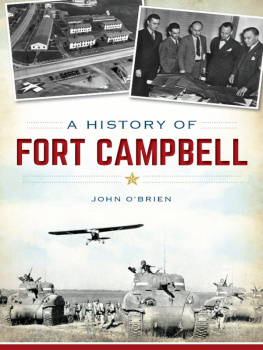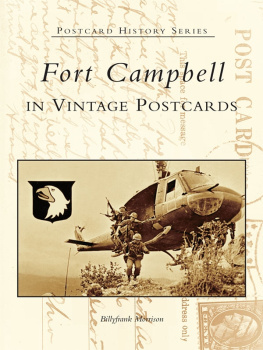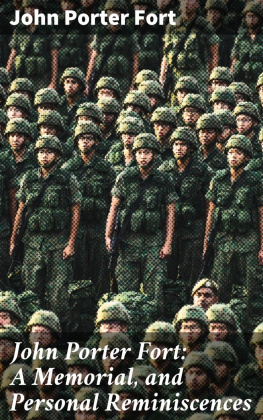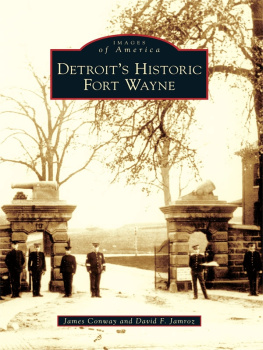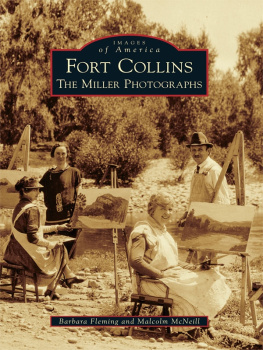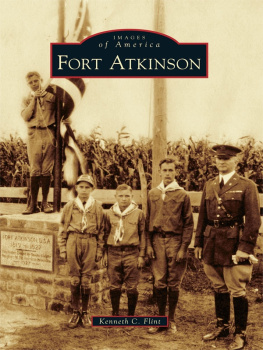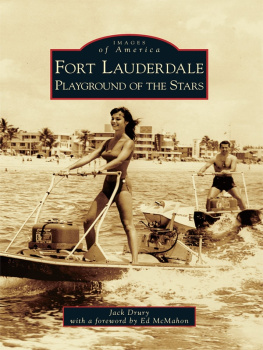
Published by The History Press
Charleston, SC 29403
www.historypress.net
Copyright 2014 by John OBrien
All rights reserved
Unless otherwise noted, all images are from the collection of the Don F. Pratt Museum.
First published 2014
e-book edition 2014
ISBN 978.1.62584.759.1
Library of Congress Control Number: 2014953182
print edition ISBN 978.1.62619.275.1
Notice: The information in this book is true and complete to the best of our knowledge. It is offered without guarantee on the part of the author or The History Press. The author and The History Press disclaim all liability in connection with the use of this book.
All rights reserved. No part of this book may be reproduced or transmitted in any form whatsoever without prior written permission from the publisher except in the case of brief quotations embodied in critical articles and reviews.
For Colonel Arthur Lombardi and Colonel Ted Crozier: soldiers, heroes and leading citizens in the growth of the city of Fort Campbell.
in memoriam
CONTENTS
ACKNOWLEDGEMENTS
Much of the work of historical research takes place in the lonely confines of archives and libraries. In the course of my research in our archives and library, I have had the pleasure to spend time with many hardworking and talented historians who have come before me. I got to know them vicariously through their work, of which this history of the development of the city of Fort Campbell is a synthesis. Captain John Mosher wrote the first history of Fort Campbell in 1952. Clyde Jones expanded on that history in a masters thesis in 1973. Two lieutenants assigned to the Division G3 in 1965, John Jaeger and David Pearson, assembled and drafted a thorough history of Fort Campbell from 1950 through 1965. I have found several marked-up copies of their 190-page draft, but I have yet to find a finished and final copy. I suspect the events surrounding the deployment of the division to Vietnam preempted completion, but even in draft it was a most helpful document. First Lieutenant David Hart wrote a history of the fort and the division in 1978 that provided insight into the United States Army Training Center years, 196772. Samiran Chanchani, with whom I did have the pleasure to work in person, assembled an excellent historical context for Fort Campbell during the Cold War years, especially the history of Clarksville Base. Captain Jim Page, a great friend and colleague, left a very complete history of the division in Operation Iraqi Freedom and the Global War on Terror. I am also indebted to the work of colleague and friend Scott Schoner. Scotts work of organizing and digitizing the document and pictorial archives at the Pratt Museum was meticulous and thorough, making access to such records a breeze. The names of numerous other officers who performed the additional duty of division historian, normally a one-year or less assignment, are associated with a large archive and library of Annual Historical Reports and supplements, special studies, replies to historical inquiries and other artifacts of their work that have been essential. To all these, I am indebted.
Fortunately, not all historical research is done in the dark and lonely confines of archives and libraries. Over the years of my association with Fort Campbell as an active-duty officer and as a Department of the Army civilian, I have had the privilege of sharing the daylight and true conviviality with many colleagues, both active-duty military and civilian, who have shared their knowledge and insights about the development of the city. Many of them were not just witnesses but actual participants in the shaping of events. To mention just a few: Jody Jenkins of DPTMS; Director of Contracting Leslie Carrol (who once challenged me that it would not be possible to write a history of the city and thus generated the intellectual curiosity and drive to make this attempt!); Gregory Stallworth of the Equal Opportunity Office and founder of the civilian workforce development program Leadership Fort Campbell; Van Stokes of MWR, Mr. Outdoor Recreation; and Helen Zachary and Teresa Mueller of the Strategic Planning Office, who have long plotted and articulated the plan of development for the city for at least a decade of very successful garrison commanders. As a historian, there is a special place in my heart for the engineers on post. If you want to know the physical history of a city, consult the engineer. Master planner Sally Castleman and Deputy Post Engineer Ted Reece, with their insights and with her archive of records, maps and master plans, are wonderful resources for historical inquiry of this kind.
The mission to collect, preserve, interpret and exhibit the history, heritage and values of the city of Fort Campbell and the units that have been assigned is an Army mission that has been greatly enhanced by the moral and financial support of the Fort Campbell Historical Foundation, Inc. The support of the foundation for the historical program, the Don F. Pratt Museum and the future Wings of Liberty Museum is very much a part of the many ways the foundation helps to keep Fort Campbell a world-class Army home.
A last and heartfelt bit of gratitude must go out to friends and family who encouraged me in this project. Thank you to museum colleagues John Foley, Dan Peterson and Captain Tyler Reid for sharing the research burden and enduring the reading of draft chapters. Thank you to our 2014 Pratt Museum summer intern, Sarah Fry of the Middle Tennessee State University graduate program in public history, for proofreading, identifying all those split infinitives and killing passive voice whenever it tried to creep into the manuscript. I owe a special thank-you to my daughter, Bernadette, for her proofreading and insistence on a smooth narrative free of military jargon and Army speak. Lastly, my most special thank-you goes to my Army bride of thirty-six years, Maria, who has always been the heart and soul of our Army family.
INTRODUCTION
Gate 4, pictured on the back cover, has been the main entrance into Fort Campbell since the camp was constructed in February 1942. The entrance road passes a guard post at Gate 4 and then heads west one mile to the geographic center and highest elevation of the camp. At that spot stands Building T-39, a building that for most of the history of the city of Fort Campbell has served as the combined headquarters for Garrison Command and the headquarters of the commanding general of the major unit assigned to Fort Campbell.
These two iconic features, Gate 4 and T-39, tell us much about the history of Fort Campbell. The T associated with a building on an engineer site plan stands for temporary. This building, T-39, on the site plan for what was conceptually known as the Tennessee-Kentucky Armor Camp in 1941 was a division and administration headquarters building of the standard design recently approved by the quartermaster general for Army camps (Type DHQ-1). Every mobilization camp built for World War II had a headquarters administration building of the same design, one each per camp. The T indicated that the service life of the building, like that of the camp itself, was not expected to exceed the length of time it would take to fight and win the war. A maximum service life of five to twenty years was the construction standard for all buildings designed for the mobilization camps.
Now, seventy years later, T-39 still stands and still serves as the headquarters building for the Fort Campbell Garrison Command. It is no small irony that over those many years, almost everyone forgot what the T stood for. Im headed to T-39 became a well-understood euphemism used by subordinate commanders, staff officers and couriers to mean, Im headed for the headquarters. One goal of this history is to explain how this temporary mobilization camp built in the Black Patch of Tennessee and Kentucky for the Great Crusade of World War II has managed to remain relevant and transform to become the modern city of Fort Campbell. The answer to that question that will unfold in this history is that the decisions made in 1941 to locate the camp here were made for the right reasons. They were decisions based on a set of criteria learned from recent trial and error in the Army mobilization camp construction program. Those who made the decisions were free from inappropriate political interference. The decisions made for the right reasons in 1941 proved enduring, and hence, the camp was adaptable and uniquely suited for continued service as the nations security needs changed throughout the subsequent decades.
Next page
